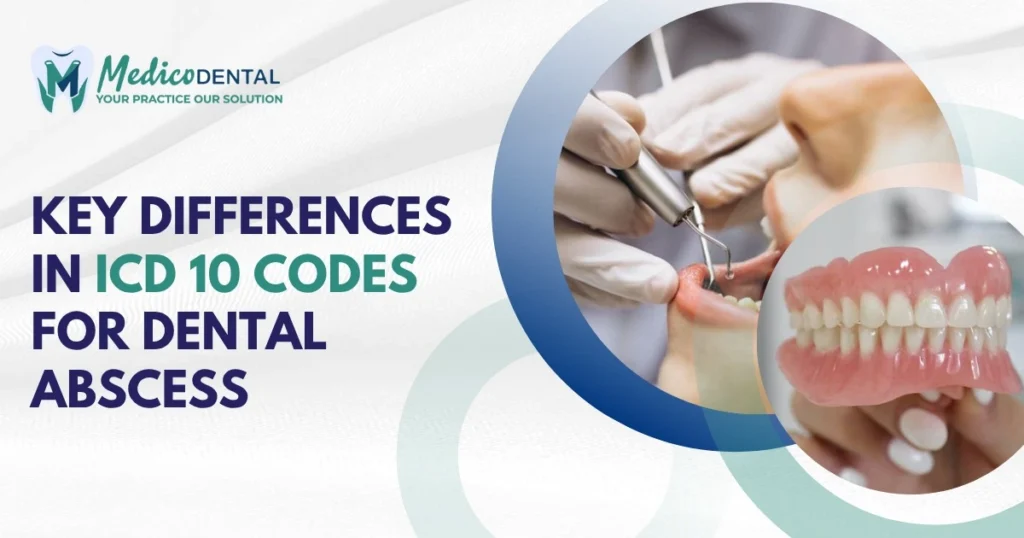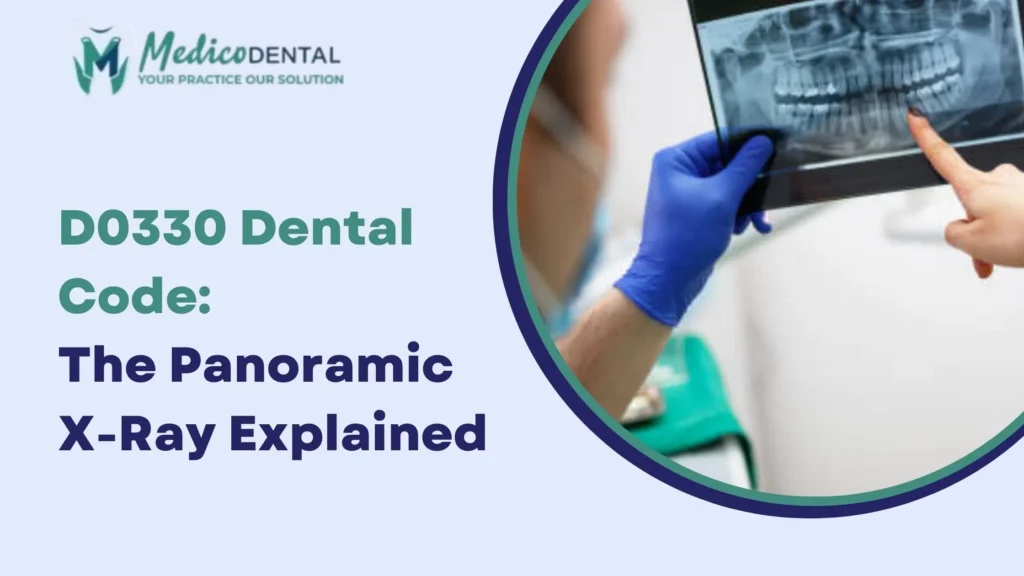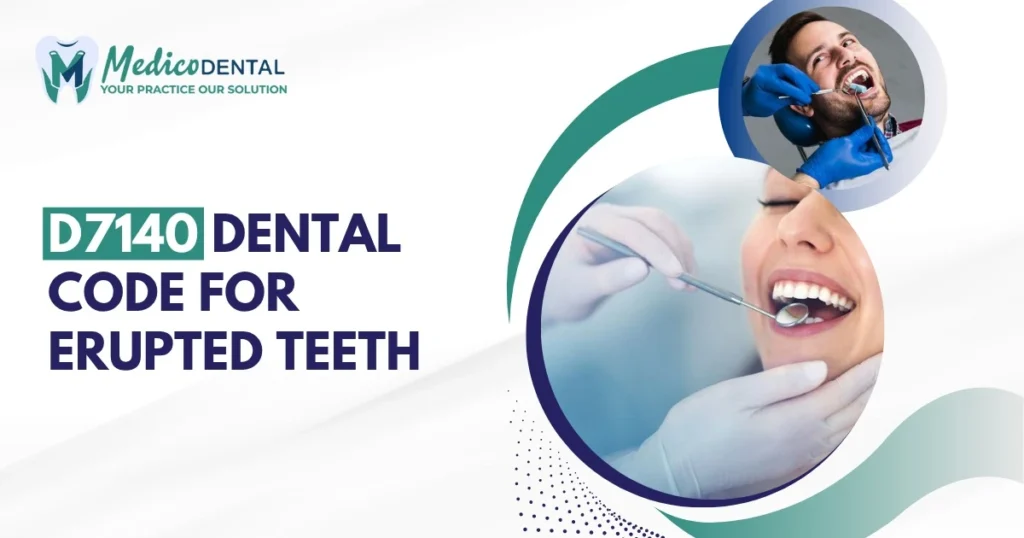A dental abscess is a painful bacterial infection that forms a pocket of pus within or around a tooth. It often results from untreated decay, gum disease, or trauma. In clinical practice, accurate ICD 10 coding plays a vital role in diagnosing, documenting, and ensuring proper insurance reimbursement for dental abscess cases.
Understanding Dental Abscess
What is a dental abscess?
A dental abscess occurs when bacteria invade the soft tissue or bone surrounding a tooth, leading to infection and pus buildup. It can affect the tooth’s pulp, root, or surrounding gum tissue, causing severe pain, swelling, and discomfort.
Causes and symptoms
Common causes include untreated tooth decay, deep cavities, fractured teeth, and periodontal disease. Poor oral hygiene and weakened immunity can also increase the risk. Symptoms often include throbbing pain, sensitivity to hot or cold, swelling of the face or gums, fever, and an unpleasant taste due to drainage of pus.
Types of dental abscesses (periapical, periodontal, gingival)
- Periapical abscess: Forms at the tip of the tooth’s root, often due to infection spreading from the pulp.
- Periodontal abscess: Develops in the supporting gum structures due to gum disease.
- Gingival abscess: Limited to the gum surface, usually caused by trapped food particles or debris.
Importance of ICD 10 Coding for Dental Conditions
Why precise ICD 10 codes matter for documentation and reimbursement
Accurate ICD 10 coding ensures that a patient’s diagnosis is correctly recorded and communicated for billing, treatment planning, and insurance claims. It helps dental professionals justify the need for treatment, facilitates data collection for research, and prevents claim denials or reimbursement delays. When a patient requires complex surgical intervention, like the placement of an implant body often represented by the D6010 Dental Code, clear documentation of the underlying pathology (the abscess) using the correct ICD 10 code is critical to establishing medical necessity for the entire treatment course.
Common challenges in coding dental abscesses
Coding dental abscesses can be tricky when documentation is incomplete or the abscess type isn’t clearly defined. Clinicians may confuse abscesses with or without sinus tracts, leading to inaccurate code selection. Additionally, missing details like the specific tooth involved can result in rejected or delayed claims.
ICD 10 Codes for Dental Abscess
K04.6 Periapical Abscess with Sinus
Definition
This code is used when a periapical abscess is accompanied by a sinus tract, which allows pus to drain through the gum or skin surface.
When to use this code
Use K04.6 when there is a visible or palpable sinus tract connected to the infected tooth root. It typically indicates a chronic infection that has progressed beyond the apex of the tooth.
Clinical example
A patient presents with a small draining pimple like lesion on the gum near a decayed molar. Examination and X rays confirm a periapical abscess with a sinus tract leading from the infected root to the gum surface.
K04.7 Periapical Abscess without Sinus
Definition
K04.7 applies to infections at the tooth root where pus accumulates but does not form a drainage pathway or sinus tract.
When to use this code
Use this code when a patient has localized swelling, pain, and sensitivity, but there is no visible sinus or fistula. It represents a confined infection that has not yet broken through surrounding tissues.
Clinical example
A patient complains of sharp pain and tenderness in a tooth. Radiographic imaging shows an abscess at the root tip without any drainage pathway. The dentist assigns K04.7 to document the diagnosis.
K12.2 Cellulitis and Abscess of Mouth
Definition
K12.2 refers to infections involving the soft tissues of the mouth, often with spreading inflammation known as cellulitis.
When to use this code
Use K12.2 when a dental abscess extends beyond the tooth or gum and causes diffuse swelling, redness, or systemic symptoms like fever. It’s appropriate when soft tissue inflammation accompanies the abscess.
Clinical example
A patient presents with swelling that extends from the lower jaw to the cheek, accompanied by fever and pain. The infection has spread from a tooth abscess to the surrounding tissues, so K12.2 is the suitable code.
Coding Tips and Best Practices
How to determine the correct ICD 10 code
Always review the clinical notes, radiographs, and the presence or absence of a sinus tract before selecting a code. Identify the abscess type (periapical, periodontal, or gingival) and whether it involves cellulitis or soft tissue infection.
When to include a specific tooth code
If the abscess is localized to a particular tooth, include the appropriate tooth code or notation in the patient’s record. This enhances clarity for both clinical documentation and billing accuracy.
Differentiating between abscess with and without sinus
A sinus tract indicates chronic infection and requires the use of K04.6. Without a tract, the correct code is K04.7. Proper examination and imaging help distinguish between the two conditions.
Linking diagnosis to procedure codes (if applicable)
Ensure the ICD 10 diagnosis aligns with the performed procedure, such as drainage, root canal therapy, or tooth extraction. Linking diagnosis and procedure codes properly prevents claim denials and maintains compliance with payer requirements. This alignment also relies heavily on initial insurance verification to confirm procedure coverage before treatment is rendered.
Common Mistakes in Dental Abscess Coding
Misidentifying abscess location
One of the most frequent errors in dental coding is failing to identify where the abscess originates. A periapical abscess forms at the tooth root, while a periodontal abscess starts in the gum or supporting tissues. Mixing these up can lead to incorrect ICD 10 selection, which may cause confusion in diagnosis, treatment planning, or insurance billing. Always confirm the abscess location through clinical examination and radiographs before assigning a code.
Ignoring sinus tract presence
The presence or absence of a sinus tract determines whether K04.6 or K04.7 should be used. Ignoring this detail can result in a coding error that affects both documentation accuracy and claim approval. Dentists should carefully note if drainage is visible or if imaging shows a fistulous connection, as this directly impacts code selection.
Not coding secondary infections (like cellulitis)
In some cases, an abscess spreads to nearby tissues and causes cellulitis a serious condition involving diffuse inflammation and swelling. Failing to add K12.2 (Cellulitis and abscess of mouth) as a secondary diagnosis may lead to underreporting the severity of the infection. Always include additional codes when complications like cellulitis, fever, or lymph node involvement are present.
Example Scenarios
Example 1: Periapical abscess with sinus
A patient arrives with a small draining bump on the gum near a decayed molar. On examination, the dentist identifies a sinus tract leading from the tooth’s root apex. The appropriate ICD 10 code here is K04.6 Periapical abscess with sinus, since pus is draining through a visible tract. The treatment may involve root canal therapy or extraction to eliminate the infection source.
Example 2: Periapical abscess without sinus
Another patient presents with severe tooth pain, tenderness, and swelling around a specific tooth, but no drainage is visible. X rays confirm infection at the root tip without a sinus tract. The correct ICD 10 code in this case is K04.7 Periapical abscess without sinus. The dentist may recommend antibiotics and root canal treatment to prevent the abscess from worsening.
Example 3: Abscess with cellulitis
A patient experiences facial swelling that extends from the lower jaw to the neck, with fever and difficulty opening the mouth. The infection has spread from a decayed tooth to the surrounding soft tissues. In this case, K12.2 Cellulitis and abscess of mouth is the most appropriate code, as it captures both the abscess and the soft tissue involvement. The condition requires urgent treatment to prevent systemic complications.
Related ICD 10 Codes
K04.8: Other specified diseases of pulp and periapical tissues
This code applies when there are other defined conditions affecting the dental pulp or periapical tissues that do not fit under abscess specific categories. It’s used when the diagnosis involves unusual or secondary pulp pathologies.
K04.9: Unspecified diseases of pulp and periapical tissues
When documentation lacks enough detail to identify the exact nature of the infection or disease, K04.9 should be used. This code indicates that a pulp or periapical issue exists but hasn’t been specifically classified.
K05.2: Acute periodontitis
This code refers to inflammation and infection of the tissues surrounding the tooth, distinct from periapical abscesses. It’s used when the condition originates in the gums or supporting structures rather than the root canal system. Proper distinction between periodontitis and periapical abscess ensures accurate coding and clinical documentation.
Summary
Quick recap of key ICD 10 codes
Dental abscesses are coded primarily under:
- K04.6 Periapical abscess with sinus
- K04.7 Periapical abscess without sinus
- K12.2 Cellulitis and abscess of mouth
Each code corresponds to a specific presentation of infection, ensuring precise documentation and billing accuracy.
Emphasis on accuracy for improved patient care and billing compliance
Accurate ICD 10 coding does more than streamline billing it supports better diagnosis, treatment planning, and recordkeeping. Recognizing whether a sinus tract or cellulitis is present allows for correct code selection, minimizing claim denials and reflecting the true severity of the condition. Consistent, thorough documentation is key to maintaining both compliance and high quality dental care
FAQs
What is the ICD 10 code for a dental abscess?
Ans.The ICD 10 codes for dental abscesses include K04.6 (Periapical abscess with sinus), K04.7 (Periapical abscess without sinus), and K12.2 (Cellulitis and abscess of mouth). The correct code depends on whether a sinus tract or soft tissue infection is present.
How do I know whether to use K04.6 or K04.7?
Ans.Use K04.6 when the abscess has a sinus tract that allows drainage of pus through the gum or skin.
Use K04.7 when the infection is localized without any visible or palpable drainage pathway.
A clinical examination and X ray usually help determine which code applies.
When should I use K12.2 for a dental abscess?
Ans. K12.2 Cellulitis and abscess of mouth should be used when the infection extends beyond the tooth and affects the surrounding soft tissues. This often appears as swelling, redness, or fever and may require urgent medical attention.
Can a dental abscess cause cellulitis?
Ans. Yes. If a dental abscess is left untreated, bacteria can spread to nearby soft tissues, leading to cellulitis, which causes painful swelling and can become a serious condition. That’s why coding both the abscess and cellulitis correctly is essential for accurate documentation and treatment.
Why is ICD 10 coding important for dental abscesses?
Ans. Accurate ICD 10 coding ensures proper diagnosis documentation, helps dentists communicate clearly with insurance companies, and prevents claim denials. It also supports clinical accuracy and legal compliance in patient records.



